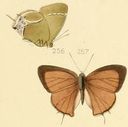Hodges#4320
Callophrys xami
Classification
- Phylum: Arthropoda
- Subphylum: Hexapoda
- Class: Insecta
- Order: Lepidoptera
- Superfamily: Papilionoidea
- Family: Lycaenidae
- Subfamily: Theclinae
- Tribe: Eumaeini
- Genus: Callophrys
- Species: xami
Pronunciation
How to pronounce Callophrys xami: /ˈkæləˌfrɪs ˈzæmi/
These audio files are automatically generated. While they are not always 100% accurate, they are a good starting point.
Images


Summary
Callophrys xami, commonly known as the succulent hairstreak or green hairstreak, is a rare butterfly found mainly in the southern U.S. and parts of Central America. It is characterized by its unique wing patterns and territorial behavior among males. The species relies on specific host plants for feeding and oviposition.
Physical Characteristics
C. xami has a wingspan range of 2.38 to 2.86 cm. The underside of the hindwing is yellowish green with a discernible postmedian white line that forms a W-shape towards the tails of the butterfly. Eggs are spherically shaped and slightly flattened, approximately 0.7 to 0.8 mm in diameter and 0.5 mm in height.
Identification Tips
Distinguished from similar species such as the juniper hairstreak and silver-banded hairstreak by the presence of the sharp W mark in the postmedian white band on the hindwing. The juniper hairstreak lacks this feature, while the silver-banded hairstreak has a broader silver-white postmedian line.
Habitat
Found near coniferous woodland forests and relatively sunny areas along mountain and canyon slopes.
Distribution
Primarily found in southern Arizona and central Texas, extending down to Mexico and Guatemala.
Diet
Larvae primarily feed on host plants from the genera Echeveria and Sedum, which are native to parts of western and southwestern United States and Mexico.
Life Cycle
The life cycle includes egg, larval, pupal, and adult stages, with eggs taking about seven days to hatch. The larval and pupal stages vary in duration and characteristics.
Reproduction
Mating is characterized by polygyny, with males defending territories that serve as mating stations. Females oviposit on the underside of host plant leaves after mating.
Predators
C. xami uses wing morphology to mimic a false head to deter visually-oriented predators such as mantises and birds.
Ecosystem Role
Acts as a pollinator and plays a role in the food web as both prey and predator.
Evolution
C. xami exhibits traits that are evolutionary adaptations for both mating and anti-predation strategies.
Similar Taxa
- Juniper hairstreak
- Silver-banded hairstreak
Tags
- butterfly
- Lepidoptera
- Lycaenidae
- taxonomy